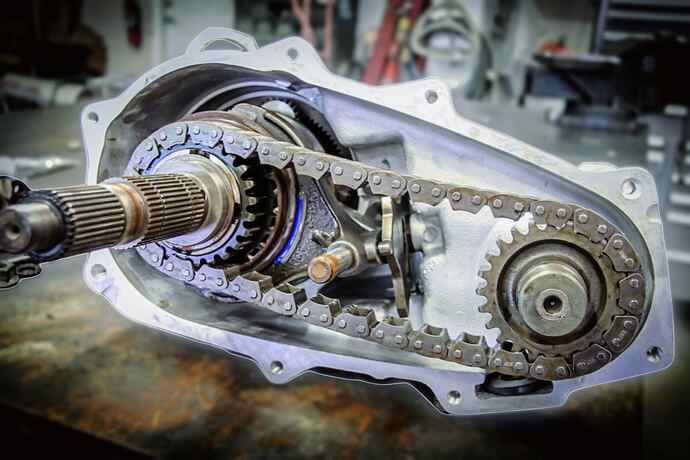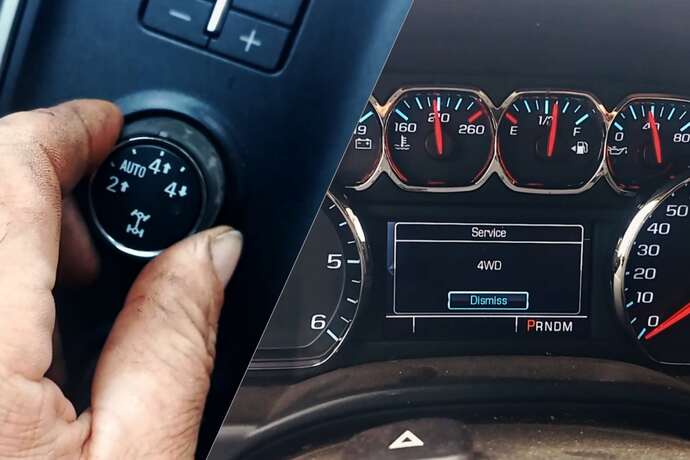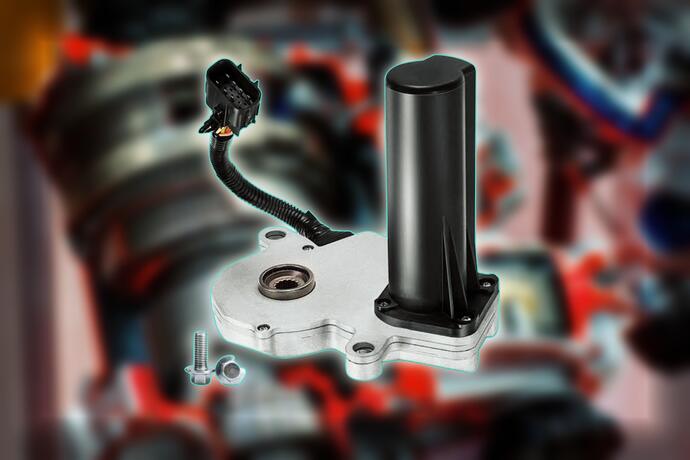The Chevy Silverado is a great truck with off-road capabilities. Most Silverados come with both 2WD and 4WD modes. However, Silverado has some common problems and the transfer case problem is one of them.
The transfer case is an important part of the vehicle to switch between 2WD and 4WD. You should know about transfer case problems in your Silverado to diagnose and solve the issues on time.
In this article, I have discussed the Chevy Silverado transfer case problems, causes, symptoms, solutions, and the replacement process.
The Chevy Silverado shows the seven most common transfer case problems, including noise and vibration, fluid leak, damaged transfer chain, 4WD malfunction, fluid seal leak, control module issues, and encoder motor problems.
Problem 1: Transfer Case Noise and Vibration

You may hear humming and grinding noises coming out of the transfer case of your Chevy Silverado. Friction and worn-out lubricant oil cause humming noises.
Old fluids get too dirty and are unable to lubricate the components. You need to change the transfer case fluid every 60,000 miles.
If you haven’t changed the transfer case fluid, the humming noise may be the main reason. Also, worn-out U-joints cause grinding noise from the transfer case.
It may also cause vibration, making driving uncomfortable. The problems appear when shifting from 2WD to 4WD.
Solution
Changing the transfer case fluid will solve the humming noise problems. Replacing the transfer case fluid costs $120–$180.
You can follow the video to change the transfer case fluid easily:
You need to replace the U-joints to solve vibration and grinding noise issues. The average cost for a U-joint replacement is $580–$620.
However, new parts may not be as good as your old U-joints and break after some time. So, I advise buying official parts or collecting parts from old transfer cases.
Problem 2: Transfer Case Leak
Chevy Silverado users reported that fluid leaked out of the transfer case. The main reason for the leak may be a microcrack or a pinhole.
Gears, chains, and a fluid pump are inside the transfer case. Small parts moving around the transfer case may wear out with time in some places.
Low transfer case fluid may also cause friction, causing the case to leak. Sometimes, there are no leaks but a broken shaft seal, which causes the fluid to leak.
Solution
You can easily solve the leaking issue by pinpointing the leak.
After finding a leak, you will have to replace the half casing of the transfer case, and the problem should be solved by now.
If the leak still exists, you should check the shaft seals and replace them to resolve the issue.
Problem 3: Damaged Transfer Chain

The transfer chain is an important component of the transfer case. The transfer chain does not stretch or wear out over time.
As a result, the transfer chain will become loose and cause a late response. It may result in trouble shifting and getting stuck in one gear.
Solution
Solving the damaged transfer chain is very easy. After confirming the issue, you should replace the transfer chain.
Replacing the transfer chain will cost you around $100–$200. It is not very costly compared to replacing the transfer case. Hopefully, it will solve the issue.
Problem 4: Transfer Case Fluid Seal Leak
There is a separator seal for transfer case fluid and transmission fluid. The seal can break or leak over time, causing transmission and transfer case fluid to mix.
Users may notice low levels of transmission fluid overnight due to the issue. Generally, seal breaking occurs during towing.
Solution
You should remove the transfer case and replace the separator seal. This should solve the low transmission fluid issue.
Problem 5: 4WD Not Working Properly

Users reported that sometimes the 4WD system stops working. Sometimes, the gear keeps popping out of the transfer case.
The service 4WD light may come on, and the 4WD system stops working.
Faulty sensors, a bad case motor, a bad sensor switch, or a faulty transfer case control module are the root causes of these problems.
Solution
You must diagnose the vehicle with an OBD-II scanner to pinpoint the issue. If the problem is with sensors, you should replace them right away.
If the problem is with the transfer case encoder motor or the control module, you may need to replace them, too.
Problem 6: Transfer Case Control Module Issues
The transfer case control module is a very important part of the transfer case. It helps shift the driving modes and control other sensors to synchronize with your driving.
Wiring problems, physical harm, water damage, overheating, electrical surges, and other factors could harm TCCM.
You will face 4WD problems, shifting issues, noise, vibration, check engine light issues, etc., if there are problems with the TCCM.
Solution
The most common solution is to reset the transfer case control module. This will reset the driving data and learn your new driving data.
If the problem is not resolved, you may need to replace the TCCM, which costs around $450–$500.
If the problem persists, you should take your truck to a nearby mechanic shop.
Problem 7: Transfer Case Encoder Motor Problem

The transfer case encoder motor is responsible for shifting gears in the transfer case. You may find your truck stuck in neutral and not shifting properly.
The encoder motor works with the TCCM and automatically shifts as necessary.
Solution
You have to replace the transfer case encoder motor to solve the issue. According to quality, the encoder motor costs around $120 to $150.
What Is a Transfer Case?

A transfer case is a module that transfers the power from your engine to the axles and switches between 2WD and 4WD modes. Generally, engine power is transferred through a single shaft to the front or rear axle.
As a result, 2WD mode is operational in general. But 4WD needs both the front and rear axles to work, and the engine power transfers through two shafts.
The transfer case is essential for connecting the front and rear shafts and switching between 2WD and 4WD modes.
Otherwise, you would have to shift them manually, which could lead to mistiming and other issues. The transfer case operates automatically by working with the ECU.
If there are problems with the transfer case, you won’t be able to shift in 4WD mode but drive in 2WD mode.
Causes of Chevy Silverado Transfer Case Problems
There are many causes for the transfer case issues in your Chevy Silverado. The most common causes of the Chevy Silverado transfer case problems are:
- Low transfer case fluid level
- Old and dirty transfer case fluid
- Transfer case fluid leak
- Damaged transfer chain
- Bad transfer case sensors
- Transfer case encoder motor failure
- Transfer case control module malfunction
These are the most probable causes of transfer case problems. If you face any issues with the transfer case in your Silverado, you should look for these causes.
Symptoms of Chevy Silverado Transfer Case Problems
Your Silverado may show many symptoms of transfer case problems. As a vehicle owner, you should look out for the symptoms and solve the issues as soon as possible. The most common symptoms of Chevy Silverado transfer case problems are as follows:
- Trouble with gear shifting
- Unusual humming or grinding noise
- Transfer case fluid leaking
- Stuck in neutral
- Having trouble staying in 4WD
- Unable to engage or disengage 4WD
- Vibration while shifting
These are the common symptoms that may be an indication of transfer case problems.
Silverado Transfer Case Repair Cost

Repairing the transfer case of a Chevy Silverado is cheap. Most of the time, rebuilding a transfer case may solve the issue.
The rebuilding kit is around $100–$120, and you can try it on your own. However, hiring a mechanic will cost around $500–$700 to rebuild the transfer case.
You may need to replace the transfer case, which is very costly. A new transfer case will cost you around $2300–$2800 to purchase.
There are additional labor costs, as replacing the transfer case is hard. It takes approximately 4–5 hours to replace the case, depending on the condition of your truck.
Also read Chevy Silverado transmission problems.
FAQs
What is the life of a transfer case?
As long as there isn’t misuse and the oil is replaced on a regular basis, a transfer case should ideally last the entire lifespan of the car. Some of the vehicles have transfer cases with over 100,000 miles on them, and there are even more with over 500,000 miles.
Can I drive with a faulty transfer case?
Although driving with a broken transfer case is technically possible, you should repair or replace it when you notice problems. Prolonging the period of fixing the transfer case may harm other costly components like transmissions, axles, etc.
How do you check transfer case fluid?
After 30,000 miles or any time you see any symptoms of a transfer case issue, you should check the fluid in your transfer case.
Though it’s a nasty task, anyone can change these fluids. You can follow the video to check the transfer case fluid in your Silverado:
How much fluid does a Silverado transfer case take?
The Chevy Silverado transfer case takes up to 1.6 quarts, or 1.514 liters, of transfer case fluid. Generally, you should buy at least 1.8 liters of fluid. The extra amount is for waste and overflowing the transfer case.
What is the transfer case recall on Chevy Silverado?
Due to transfer case problems, General Motors recalled certain Chevy Silverados from the 2014–2015 model year. By then, the transfer case had switched to neutral without the driver’s input due to an electrical signal short. GM conducted a vehicle recall to fix the problems in response to customer complaints.
Final Thoughts
The transfer case in your Silverado is a vital component. It ensures seamless transitions between 2WD and 4WD modes.
You can drive in various conditions with the traction and control that a transfer case gives you.
Maintaining and caring for your Silverado properly can help it last longer and continue to function at its peak.
If you experience any problems with the transfer case, try to identify the problem and find a solution, or bring your truck to a nearby service shop.
You can damage other crucial parts of your priceless truck if you neglect the issues for an extended period of time.
I hope you are now aware of the issues regarding the transfer case of your Silverado and how to resolve them.


